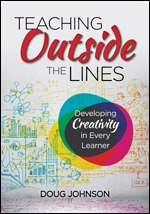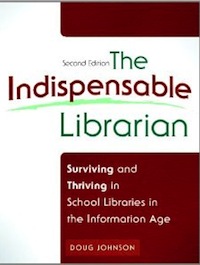Wednesday
Feb262014
Quotes from from Creativity by Csikszentmihalyi (Part 2)
 Wednesday, February 26, 2014 at 05:52AM
Wednesday, February 26, 2014 at 05:52AM  I finished reading Mihaly Csikszentmihalyi's Creativity: Flow and the Psychology of Discovery and Invention. While not aimed directly at education, he does make some observations about its influence (or lack thereof) on a person's creative abiliites. Here are a few statements that jumped out at me from the second part of his book where he write biographies of people whom he views as Big C creatives.
I finished reading Mihaly Csikszentmihalyi's Creativity: Flow and the Psychology of Discovery and Invention. While not aimed directly at education, he does make some observations about its influence (or lack thereof) on a person's creative abiliites. Here are a few statements that jumped out at me from the second part of his book where he write biographies of people whom he views as Big C creatives....insights tend to come to prepared minds, that is, to those who have thought long and hard about a given set of problematic issues. There are three main sources from which problems typically arise: personal experiences, requirements of the domain, and social pressures.
Everyone agrees that necessary as it is to listen to the unconscious, it is not sufficient. The real work begins when the emotion or idea that sprang from the uncharted regions of the psyche is held up to the light of reason, there to be named, classified, puzzled over, and related to other emotions and ideas. It is here that craft comes into play: The writer draws on a huge repertoire of words, expressions, and images used by previous writers, selects the ones most fitting to the present task, and knows how to make up new ones when needed. To do so it helps to have a broad base of knowledge that extends beyond the boundaries of literature.
The secret of saying something new is to be patient.
...the findings suggested that creativity peaked in the third decade of life, and less than 10 percent of all great contributions were made by persons over sixty.
Creative people are ever alert to what colleagues across the fence are doing. ... A large majority of our respondents were inspired by a tension in their domain that became obvious when looked at from the perspective of another domain. Even though they do not think of themselves as interdisciplinary, their best work bridges realms of ideas. Their histories tend to cast doubt on the wisdom of overspecialization, where bright young people are trained to become exclusive experts in one field and shun breadth like the plague.
When a field becomes too self-referential and cut off from reality, it runs the risk of becoming irrelevant. It is often dissatisfaction with the rigidity of domains that makes great creative advances possible.
Impara l’arte, e mettila da parte (learn the craft, and then set it aside).
Creativity testing owes its existence to World War II, when the air force commissioned J. P. Guilford, a psychologist at the University of Southern California, to study the subject. The air force wanted to select pilots who in an emergency—the unexpected failure of a gear or instrument—would respond with appropriately original behavior, saving themselves and the plane. The usual IQ tests were not designed to tap originality, and hence Guilford was funded to develop what later became known as the tests for divergent thinking.
The creative process starts with a sense that there is a puzzle somewhere, or a task to be accomplished. Perhaps something is not right, somewhere there is a conflict, a tension, a need to be satisfied.
But there are also situations in which nobody has asked the question yet, nobody even knows that there is a problem. In this case the creative person identifies both the problem and the solution. Here we have a “discovered” problem.
Even if we don’t have the good fortune to discover a new chemical element or write a great story, the love of the creative process for its own sake is available to all. It is difficult to imagine a richer life.
What is extraordinary in this case is that we talked to engineers and chemists, writers and musicians, businesspersons and social reformers, historians and architects, sociologists and physicians—and they all agree that they do what they do primarily because it’s fun.
The process of discovery involved in creating something new appears to be one of the most enjoyable activities any human can be involved in.
Neither parents nor schools are very effective at teaching the young to find pleasure in the right things. Adults, themselves often deluded by infatuation with fatuous models, conspire in the deception. They make serious tasks seem dull and hard, and frivolous ones exciting and easy. Schools generally fail to teach how exciting, how mesmerizingly beautiful science or mathematics can be; they teach the routine of literature or history rather than the adventure.
Unfortunately, there is no evidence—and probably there never will be—to prove that a delightful setting induces creativity.
Rather, what seems to happen is that when persons with prepared minds find themselves in beautiful settings, they are more likely to find new connections among ideas, new perspectives on issues they are dealing with.
Devoting full attention to a problem is not the best recipe for having creative thoughts.
Much hard work of evaluation and elaboration is necessary before brilliant flashes of insight can be accepted and applied. But without them, creativity would not be what it is.
In fact, it is impossible to tell whether a child will be creative or not by basing one’s judgment on his or her early talents.
Children can show tremendous talent, but they cannot be creative because creativity involves changing a way of doing things, or a way of thinking, and that in turn requires having mastered the old ways of doing or thinking.
If being a prodigy is not a requirement for later creativity, a more than usually keen curiosity about one’s surroundings appears to be.
Sometimes the only contribution of the parents to their child’s intellectual development is treating him or her like a fellow adult.
It is quite strange how little effect school—even high school—seems to have had on the lives of creative people. Often one senses that, if anything, school threatened to extinguish the interest and curiosity that the child had discovered outside its walls.
But if the school itself rarely gets mentioned as a source of inspiration, individual teachers often awaken, sustain, or direct a child’s interest. ... What made these teachers influential? Two main factors stand out. First, the teachers noticed the student, believed in his or her abilities, and cared. Second, the teacher showed care by giving the child extra work to do, greater challenges than the rest of the class received.
Unfortunately, one cannot be exceptional and normal at the same time.
Creativity is rarely the product of a single moment; perhaps more often it is the result of a lifetime.
... creative individuals usually are forced to invent the jobs they will be doing all through their lives.
... a culture can evolve only if there are a few souls who do not play by the usual rules.









Reader Comments